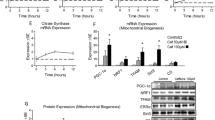Increased oxygen consumption by heart and brain mitochondria in the absence of ADP and reduced mitochondrial respiration in the presence of ADP were observed in rats exposed to stress simulated by suspension by the dorsal neck skin fold for 24 h, which attests to uncoupling of substrate oxidation and ATP synthesis and can cause electron drain from the respiratory chain, formation of ROS, and oxidative damage to cell structures. Blockade of inducible NO synthase with aminoguanidine (single intraperitoneal dose of 50 mg/kg before stress exposure) increased coupling of respiration and oxidative phosphorylation in heart and brain mitochondria of rats exposed to immobilization-painful stress, which was especially pronounced in cardiomyocytes. The test compounds glufimet (single intraperitoneal dose of 29 mg/kg before stress exposure) and phenibut (single intraperitoneal dose of 50 mg/kg before stress exposure) limited stress-induced mitochondrial damage against the background of inducible NO synthase blockade and without it, which was seen from increased respiratory control ratio in comparison with that in untreated rats exposed to stress (control).
Similar content being viewed by others
References
Kovalev GV, Gurbanov KG, Tyurenkov IN, Naidenov SN. Effect of tranquilizers on functional state of the myocardium after stress-induced damage. Eksp. Klin Farmakol. 1983;46(3):41-44. Russian.
Perfilova VN, Ostrovskii OV, Verovskii VE, Popova TA, Lebedeva SA, Dib H. Effect of Citrocard on functional activity of cardiomyocyte mitochondria during chronic alcohol intoxication. Bull. Exp. Biol. Med. 2007;143(3):341-343.
Tyurenkov IN, Perfilova VN, Popova TA, Ivanova LB, Prokofiev II, Gulyaeva OV, Stepa LI. Changes in oxidant and antioxidant status of females with experimental gestosis under the effect of GABA derivatives. Bull. Exp. Biol. Med. 2013;155(3):363-365.
Tyurenkov IN, Perfilova VN, Sadikova NV, Berestovitskaya VM, Vasil’eva OS. Effects of a New Glutamic Acid Derivative on Myocardial Contractility of stressed animals under conditions of nitric oxide synthesis blockade. Bull. Exp. Biol. Med. 2015;159(3):384-386.
Tyurenkov IN, Perfilova VN, Sadikova NV, Prokofiev II. NO-dependent mechanism of the cardioprotective action of phenibut on stress-induced violation of contractile function of the heart. Eksp. Klin Farmakol. 2015;78(11):8-11. Russian.
Udintsev NA, Ivanova VV. Antioxidant effects of glutamic acid. Patol. Fiziol. 1984;4:60-62. Russian.
Brand MD, Nicholls DG. Assessing mitochondrial dysfunction in cells. Biochem. J. 2011;435(2):297-312. Erratum in: Vol. 437(3):575.
Cossenza M, Cadilhe DV, Coutinho RN, Paes-de-Carvalho R. Inhibition of protein synthesis by activation of NMDA receptors in cultured retinal cells: a new mechanism for the regulation of nitric oxide production. J. Neurochem. 2006;97(5):1481-1493.
Fulda S, Gorman AM, Hori O, Samali A. Cellular stress responses: cell survival and cell death. Int. J. Cell Biol. 2010;2010. ID 214074. doi: 10.1155/2010/214074.
Lanza IR, Nair KS. Functional assessment of isolated mitochondria in vitro. Methods Enzymol. 2009;457:349-372.
Laszlo F, Evans SM, Whittle BJ. Aminoguanidine inhibits both constitutive and inducible nitric oxide synthase isoforms in rat intestinal microvasculature in vivo. Eur. J. Pharmacol. 1995;272(2-3):169-175.
Olivenza R, Moro MA, Lizasoain I, Lorenzo P, Fernandez AP, Rodrigo J, Bosca L, Leza JC. Chronic stress induces the expression of inducible nitric oxide synthase in rat brain cortex. J. Neurochem. 2000;74(2):785-791.
Viswanatha GL, Shylaja H, Rao KS, Ashwini Y, Kumar VR, Mohan CG, Sunil VG, Kumar MV, Rajesh S. Amelioration of immobilization stress-induced biochemical and behavioral alterations and mitochondrial dysfunction by naringin in mice: possible mechanism of nitric oxide modulation. J. Chin. Integr. Med. 2011;9(11):1254-1263.
Wang CH, Wu SB, Wu YT, Wei YH. Oxidative stress response elicited by mitochondrial dysfunction: implication in the pathophysiology of aging. Exp. Biol. Med. (Maywood). 2013;238(5):450-460.
Author information
Authors and Affiliations
Corresponding author
Additional information
Translated from Byulleten’ Eksperimental’noi Biologii i Meditsiny, Vol. 163, No. 2, pp. 190-193, February, 2017
Rights and permissions
About this article
Cite this article
Perfilova, V.N., Popova, T.A., Prokofiev, I.I. et al. Effect of Phenibut and Glufimet, a Novel Glutamic Acid Derivative, on Respiration of Heart and Brain Mitochondria from Animals Exposed to Stress against the Background of Inducible NO-Synthase Blockade. Bull Exp Biol Med 163, 226–229 (2017). https://doi.org/10.1007/s10517-017-3772-4
Received:
Published:
Issue Date:
DOI: https://doi.org/10.1007/s10517-017-3772-4




